Güneş Karabulut Kurt
Federated Learning for UAV-Based Spectrum Sensing: Enhancing Accuracy Through SNR-Weighted Model Aggregation
Nov 17, 2024Abstract:The increasing demand for data usage in wireless communications requires using wider bands in the spectrum, especially for backhaul links. Yet, allocations in the spectrum for non-communication systems inhibit merging bands to achieve wider bandwidth. To overcome this issue, spectrum-sharing or opportunistic spectrum utilization by secondary users stands out as a promising solution. However, both approaches must minimize interference to primary users. Therefore, spectrum sensing becomes vital for such opportunistic usage, ensuring the proper operation of the primary users. Although this problem has been investigated for 2D networks, unmanned aerial vehicle (UAV) networks need different points of view concerning 3D space, its challenges, and opportunities. For this purpose, we propose a federated learning (FL)-based method for spectrum sensing in UAV networks to account for their distributed nature and limited computational capacity. FL enables local training without sharing raw data while guaranteeing the privacy of local users,lowering communication overhead, and increasing data diversity. Furthermore, we develop a federated aggregation method, namely FedSNR, that considers the signal-to-noise ratio observed by UAVs to acquire a global model. The numerical results show that the proposed architecture and the aggregation method outperform traditional methods.
Measurement-Based Modeling of Short Range Terahertz Channels and Their Capacity Analysis
Jun 14, 2023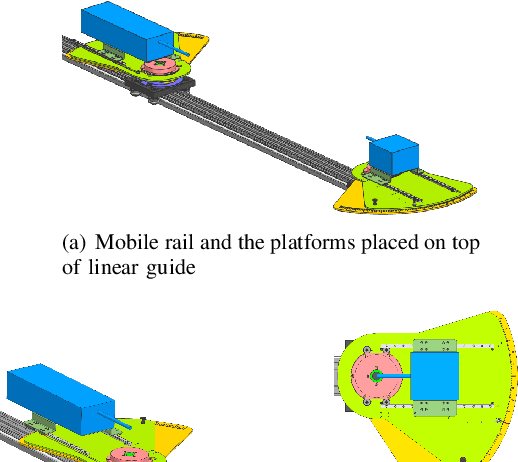
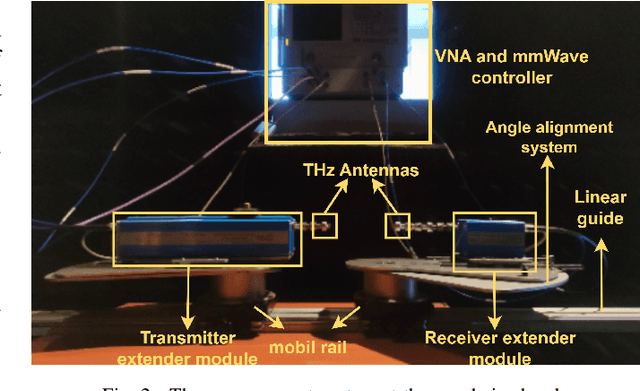
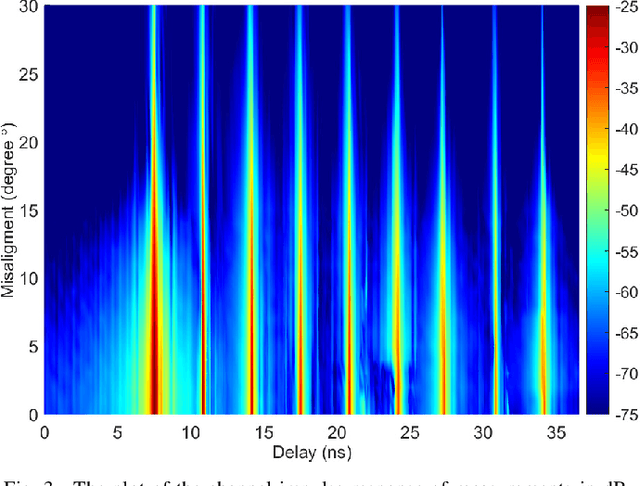
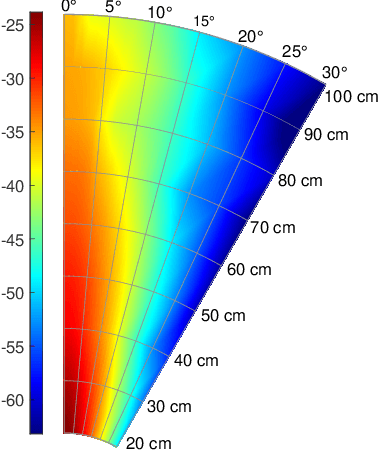
Abstract:In this work, extensive propagation characteristics of short range 240 to 300 GHz terahertz (THz) channels are mapped based on a measurement campaign conducted utilizing a novel, task specific measurement system. The measurement system allows collecting measurements from different distances and orientations in a very fine grained resolution, which is a particular issue in achieving realistic THz channel estimation. After the accurate measurement results are obtained, they are investigated in terms of channel impulse and channel frequency response. Furthermore, the fading channel amplitude histograms are modeled with the Gamma mixture model (GMM). The expectation-maximization (EM) algorithm is utilized to determine the corresponding mixture parameters. Also, to demonstrate the flexibility of the GMM, the Dirichlet process Gamma mixture model (DPGMM) is utilized in cases where the EM algorithm fails to represent histograms. Moreover, the suitability of the GMM is evaluated utilizing Kolmogorov Smirnov tests. Results verify that the GMMs can simulate the fading channel of micro-scale THz wireless communication in a realistic way, providing important implications regarding the achievable capacity in these channels. Finally, the average channel capacity of each link is evaluated using the probability density function of GMMs to gain deeper insight into the potential of micro-scale THz communications.
Experimental Assessment of Misalignment Effects in Terahertz Communications
May 23, 2023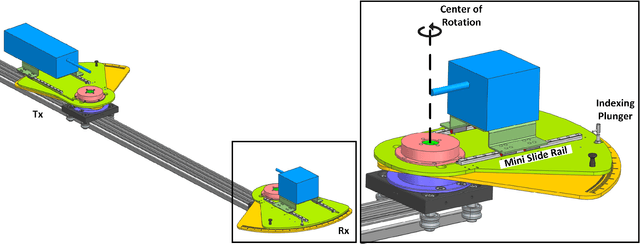
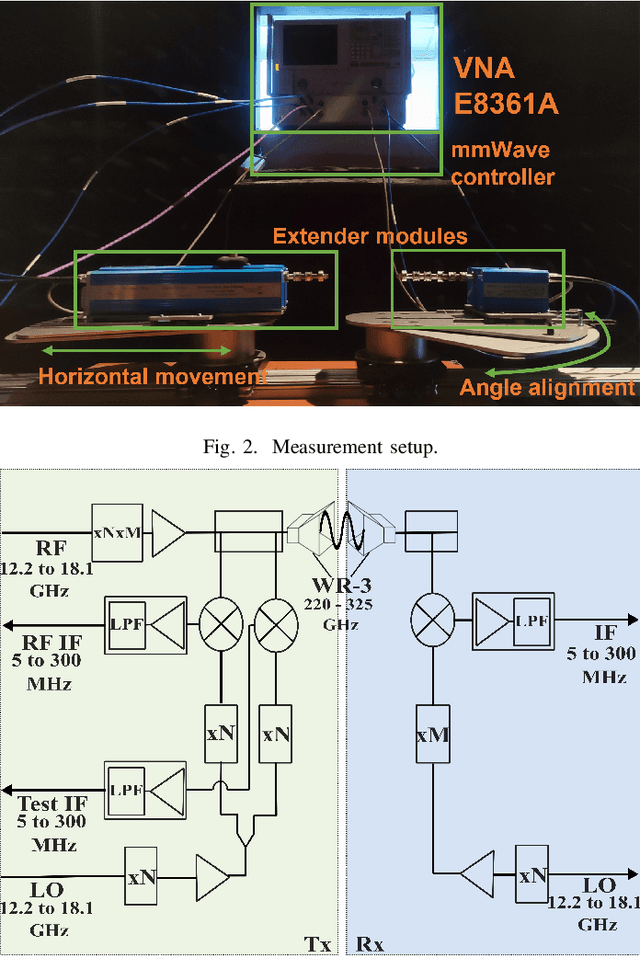
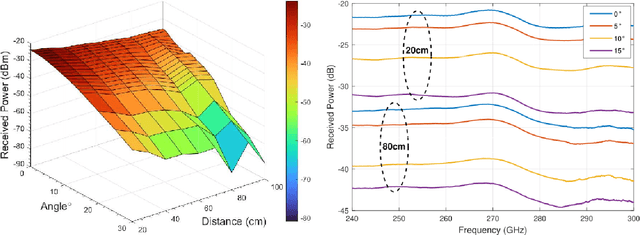
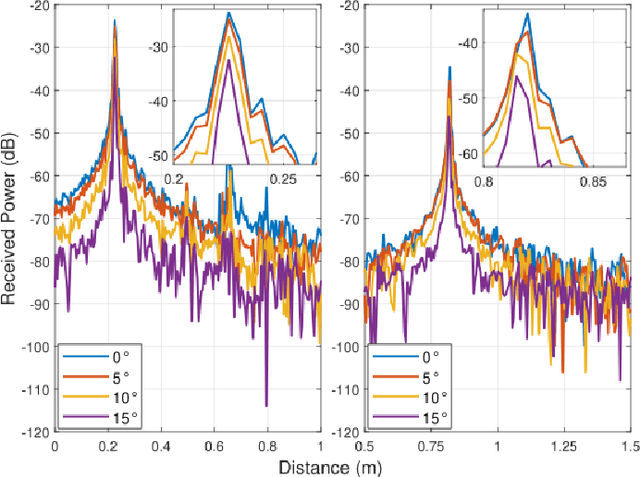
Abstract:Terahertz (THz) frequencies are important for next generation wireless systems due to the advantages in terms of large available bandwidths. On the other hand, the limited range due to high attenuation in these frequencies can be overcome via densely installed heterogeneous networks also utilizing UAVs in a three-dimensional hyperspace. Yet, THz communications rely on precise beam alignment, if not handled properly results in low signal strength at the receiver which impacts THz signals more than conventional ones. This work focuses on the importance of precise alignment in THz communication systems and the significant effect of proper alignment is validated through comprehensive measurements conducted through a state-of-the-art measurement setup, which enables accurate data collection between 240 GHz to 300 GHz at varying angles and distances in an anechoic chamber eliminating reflections. By analyzing the channel frequency and impulse responses of these extensive and particular measurements, this study provides the first quantifiable results in terms of measuring the effects of beam misalignment in THz frequencies.
Multi-State Inter-Satellite Channel Models
May 12, 2023Abstract:The advancement in satellite networks (SatNets) offers vast opportunities for large-scale connectivity and flexibility. The intersection of inter-satellite communication (ISC) and the developments in rate-hungry enhanced mobile broadband (eMBB) services have resulted in potential ultra-dense deployments such as mega-constellations. The integration of inter-satellite links (ISL) with high spectrum bands requires a well-defined channel model to anticipate possible challenges and provide solutions. In this research, we address the key concerns for defining SatNets channels and establish a comprehensive node-to-node ISL channel model for the Markov state model. The model takes into consideration satellite mobility, celestial body radiation, and cumulative thermal noise. Using this model, we analyze the bit error rate, outage, and achievable capacity of various ISC cases and propose a state-based power allocation method to improve their performance.
CNN-aided Channel and Carrier Frequency Offset Estimation for HAPS-LEO Links
Jun 26, 2022



Abstract:Low Earth orbit (LEO) satellite mega-constellation networks aim to address the high connectivity demands with a projected 50,000 satellites in less than a decade. To fully utilize such a large-scale dynamic network, an air network composed of stratospheric nodes, specifically high altitude platform station (HAPS), can help significantly with a number of aspects including mobility management. HAPS-LEO network will be subject to time-varying conditions, and in this paper, we introduce an artificial intelligence (AI)-based approach for the unique channel estimation and synchronization problems. First, channel equalization and carrier frequency offset with residual Doppler effects are minimized by using the proposed convolutional neural networks based estimator. Then, the data rate is compounded by increasing spectral efficiency using non-orthogonal multiple access method. We observed that the proposed AI-empowered HAPS-LEO network provides not only a high data throughput per second but also higher service quality thanks to the agile signal reconstruction process.
A Novel LFM Waveform for Terahertz-Band Joint Radar and Communications over Inter-Satellite Links
May 24, 2022



Abstract:There is no doubt that we need to keep our eyes on the sky as satellite networks aim to address the demands of 6G and beyond communications systems. On the other hand, existence of millions of space debris pieces, large or small, poses a threat to the new space communications systems which consist of large number of small satellites, especially in the low-orbit. In this study, a dual-functioning pulsed linear frequency modulated (LFM) waveform at Terahertz (THz) bands is proposed for both wireless communications and space debris sensing over low-orbit inter-satellite links (ISLs). Initially, the ambiguity function of the proposed waveform is derived. Then, velocity and range estimation performance for radar function and bit error rate performance for the communications function are investigated. Simulation results indicate important performance gains in the THz-bands when compared to the legacy LFM systems.
Hierarchical Dirichlet Process Based Gamma Mixture Modelling for Terahertz Band Wireless Communication Channels
May 08, 2022



Abstract:Due to the unique channel characteristics of Terahertz (THz), comprehensive propagation channel modeling is essential to understand the spectrum and to develop reliable communication systems in these bands. Ray tracing and traditional statistical modeling are insufficient to construct a suitable channel model due to the wide bandwidth and rapid changes in the characteristics of THz channels. In this work, we propose the utilization of hierarchical Dirichlet Process Gamma Mixture Model (DPGMM) to characterize THz channels statistically in the absence of any prior knowledge. DPGMM provides mixture component parameters and the required number of components. A revised expectation-maximization (EM) algorithm is also proposed as a pre-step for DPGMM. Kullback-Leibler Divergence (KL-divergence) is utilized as an error metric to examine the amount of inaccuracy of the EM algorithm and DPGMM when modeling the experimental probability density functions (PDFs). DPGMM and EM algorithm are implemented over the measurements taken at frequencies between 240 GHz and 300 GHz. By comparing the results of the DPGMM and EM algorithms for the measurement datasets, we demonstrate how well the DPGMM fits the target distribution. It is shown that the proposed DPGMM can accurately describe the various THz channels as good as the EM algorithm, and its flexibility allows it to represent more complex distributions better than the EM algorithm. We also demonstrated that DPGMM can be used to model any wireless channel due to its versatility.
Wireless Power Transmission on Martian Surface for Zero-Energy Devices
Dec 03, 2021



Abstract:Exploration of the Red Planet is essential on the way through both human colonization and establishing a habitat on the planet. Due to the high costs of space missions, the use of distributed sensor networks has been investigated to make in situ explorations affordable. Along with this, the devices with ultra-low-power receivers, which are called zero-energy devices, can pave the way to further discoveries for the environment of Mars. This study focuses on wireless power transmission to provide the power desired by zero-energy devices on the Martian surface. The main motivation of this study is to investigate whether conventional harvesters and communication units can supply the required power for a long distance. The numerical results show that it is possible to deliver power to zero-energy devices without utilizing any sophisticated hardware.
Graph Attention Network Based Single-Pixel Compressive Direction of Arrival Estimation
Sep 12, 2021



Abstract:In this paper, we present a single-pixel compressive direction of arrival (DoA) estimation technique leveraging a graph attention network (GAT) based deep-learning framework. The physical layer compression is achieved using a coded-aperture technique, probing the spectrum of far-field sources incident on the aperture using a set of spatio-temporally incoherent modes. This information is then encoded and compressed into the channel of the coded-aperture. The coded-aperture based receiver exhibits a single-channel, replacing the conventional multichannel raster scan based solutions for DoA estimation. The GAT network enables the compressive DoA estimation framework to learn the DoA information directly from the measurements acquired using the coded-aperture. This step eliminates the need for an additional reconstruction step and significantly simplifies the processing layer to obtain the DoA estimate. We show that the presented GAT integrated single-pixel radar framework can retrieve high fidelity DoA information even under relatively low signal-to-noise ratio (SNR) levels.
Harmonic Retrieval of CFO and Frame Misalignment for OFDM-based Inter-Satellite Links
Aug 13, 2021


Abstract:As dense low Earth orbit (LEO) constellations are being planned, the need for accurate synchronization schemes in high-speed environments remains a challenging problem to tackle. To further improve synchronization accuracy in channeling environments, which can also be applied in the LEO networks, we present a new method for estimating the carrier frequency offset (CFO) and frame misalignment in orthogonal frequency division multiplexing (OFDM) based inter-satellite links. The proposed method requires the transmission of pilot symbols to exploit 2-D estimation of signal parameters via rotational invariance techniques (ESPRIT) and estimate the CFO and the frame misalignment. The Cramer-Rao lower bounds (CRLB) of the joint estimation of the CFO and frame misalignment are also derived. Numerical results show that the difference between the proposed method and the state-of-art method is less than 5dB at its worse.
 Add to Chrome
Add to Chrome Add to Firefox
Add to Firefox Add to Edge
Add to Edge